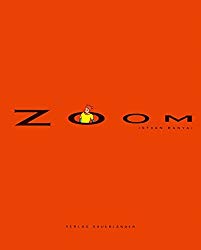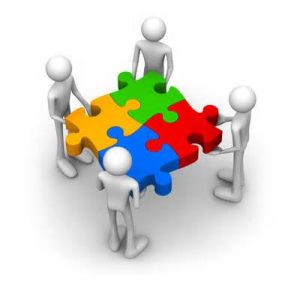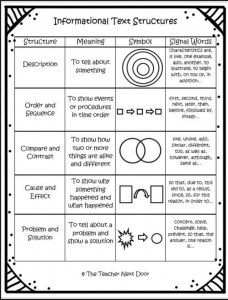IDEA #1: Text Structure “Magazine” Jigsaw
As a review of text structures, groups will create a “class magazine” in one class period! Of course, this magazine would not be something publishable or “final” in any way, shape or form. Instead, the “magazine” activity is just a vehicle for cooperative group work and content practice. This activity might come at the beginning of a non-fiction unit, because typically students know the text structures well from fourth grade and just need a refresher before they write using text structures. This uses the “jigsaw” cooperative learning model.
GOAL: Students will work cooperatively to write in various text structures.
PROCESS:
1) Students will be grouped by ability (mixed abilities) in groups of four.
2) Students will determine roles: (1) “designer” (headlines, layout, font, etc.); (2) “writers” (will write the text for the articles); (1) “editor” (proofreading).
3) The group will determine the topic of the “magazine” and then what two text structures the writers will use. Then, the writers think of subtopics that fit those text structures and write a quick first draft. Meanwhile, the designer begins sketching the layout. Editor proofreads as necessary, and helps other areas as necessary.
4) When finished, the group will reflect on how well they worked together, what they learned about working with others.
5) The next day, groups will read each other’s “magazines” and identify the text structures used.
**Click the image below for a helpful text structure reference page from The Teacher Next Door! **
IDEA #2: ZOOM Teambuilding activity
 In this learning experience, students will reassemble a cut-up version of the book Zoom by Istvan Banyai (1998). The book itself is really great for conversations about part-whole relationships (it gradually zooms out through a series of scenes). Click here to view a YouTube version of the book. I bought a used version a few years ago, tore out the pages, and had them laminated. This lesson is meant to teach about cooperation and communication and would be used when groups are formed initially. Because it is not intended to be an enduring activity that lasts multiple class periods, specific roles and jobs will not be assigned.
In this learning experience, students will reassemble a cut-up version of the book Zoom by Istvan Banyai (1998). The book itself is really great for conversations about part-whole relationships (it gradually zooms out through a series of scenes). Click here to view a YouTube version of the book. I bought a used version a few years ago, tore out the pages, and had them laminated. This lesson is meant to teach about cooperation and communication and would be used when groups are formed initially. Because it is not intended to be an enduring activity that lasts multiple class periods, specific roles and jobs will not be assigned.
GOAL: Students will work cooperatively and communicate effectively to order the images in the book Zoom.
PROCESS:
1) Students will be grouped randomly.
2) Students will be given their section of the book (4 pages). They CANNOT SHOW EACH OTHER the pages. They must only verbally describe what is going on in the pages.
3) They order themselves based on what they think is the right order from their oral descriptions. What I love about this activity is that it is easy to “self-check” — it is obvious when they’re in order.
4) After the small group has ordered their pages, they will write a brief reflection on communication.
5) Once all groups have accomplished the task, the groups will elect two representatives to participate in the ordering of ALL of the group’s pages. The other two students will take notes on how the other students communicate.
6) Finally, we’ll reveal the whole book and check the order followed by a class discussion about communication using these as guiding questions:
* What made this hard? What made this easy?
*What skills and strategies did you or members of your group use to communicate effectively?
*How did you help each other?
*How did you know you were on the right track?
*What kinds of things did your group do or say that were helpful? Not helpful?

